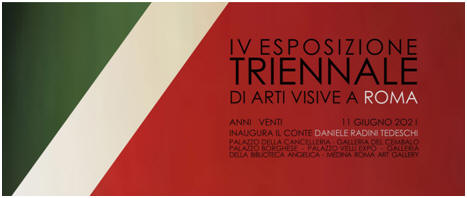Mirella Barberio_website artist
![]()
![]()
2021 - IV Esposizione Triennale di arti visive a Roma
Evento inaugurato dal conte Daniele Radini Tedeschi

Un'autostrada verso la periferia. Pittura a olio su tela, cm. 80 x 120.
A highway to the suburbs. Oil painting on canvas, cm. 80 x 120.Recensione a cura del critico d'arte Daniele Radini Tedeschi
Mirella Barberio, calabrese di nascita e genovese di adozione, è una
pittrice contemporanea, formatasi presso l’Accademia Ligustica di
Belle Arti di Genova.
Estremamente attenta e ricettiva nei confronti di ogni ambito
culturale, dalle arti figurative a quelle astratte, fino ad arrivare
alla poesia, alla musica e alla filosofia, il suo intento è quello di
elaborare una pittura che sia specchio e riflesso del proprio tempo.
Ovverosia, una pittura che sia capace di interpretare la realtà viva
che la circonda, restituendo al mondo una riflessione critica, una
visione che prenda la forma del manufatto artistico.
La ricerca artistica della Barberio prende avvio intorno alla fine
degli anni Settanta, quando, memore dei suoi studi e adottando i
codici delle “belle arti”, inizia a realizzare ritratti, nature
morte e paesaggi realistici, favorita massimamente dalla sua
personale inclinazione per il disegno.
Un vero e proprio mutamento, si registra a cavallo fra gli anni
Ottanta e Novanta quando, abbandonati gli stilemi tipici della resa
mimetica, abbraccia il tema delle atmosfere simboliste
sperimentando, in un primo tempo, un cromatismo sensoriale, in
composizioni regolate dal rigore degli accostamenti tonali, per, in
un secondo momento, proporre un’estetica che consta di vaporose
effusioni atte a disciogliere le forme naturali.
Da qui allo studio dell’Espressionismo Astratto statunitense, il
passo è breve. Nei lavori della Barberio, infatti, si fondono
polvere, colore, vernice, materia inorganica, al gesto generatore e
critico di chi dipinge, avendo in mente, temi quali: le
sollecitazioni da nature macromorfe, la fusione tra le vibrazioni di
musica e pittura, il nesso tra la materia riverberante la luce e i
moti emozionali che scaturiscono da tale attività. Come a rincorrere
il concetto di “opera d’arte
totale”, cosi come inteso dal compositore
Richard Wagner, nel 1849
e riferito alla tragedia greca, la nostra pittrice sembra
intenzionata ad avvicinarsi alle pendici di una perfetta sintesi fra
le diverse arti.
Considerando i lavori presenti in esposizione, è subito ravvisabile
la tendenza ad un’astrazione fortemente empatica, ma connotata anche
da valenze politiche.
In Autostrada verso la periferia si avvertono forti gli echi provenienti da pittori come Franz Kline, che hanno fatto del gesto pittorico crudo, tagliente, ma fortemente estetico un vero e proprio manifesto esistenziale. In questo lavoro l’artista ripercorre alcuni aspetti vissuti dall’Umanità odierna, affrontando temi che riguardano da vicino la ‘liquefazione’ delle società e delle culture alle periferie delle città attuali, corrispondenti alle ‘periferie’ presenti nell’intimo dell’essere umano. Come afferma l’artista “i limes, che in antico separavano le periferie dal centro della città, ora sono stati estesi in larga misura, alla stregua delle banlieue di oggi, cosicché queste sono divenute incubatrici di malessere, di odio e, alla fine, anche di omicidio e di strage”.
La riflessione
politico-sociale sembra sfociare nell’analisi quasi psicanalitica
del sentire umano in un’opera come
Navigando ai confini
dell’essere, in cui lo spatolato si fa più morbo e tendente
verso tenui colori pastello come il rosa, il celeste, il giallo.
Forse essa é la
paillette di un animo
umano ormai pacificato o forse sono i lidi dell’inconsistenza
ontologica ormai giunta al suo più alto grado. Significativa é la
rivisitazione, in questo periodo, dei più celebri poeti francesi del
XIX secolo: Charles
Baudelaire, Arthur Rimbaud, Stephane Mallarmé.“Questa
riproposta immedesimazione non solo rinnova in me sentimenti
provati in
passato, ma mi conduce a una profonda riflessione sul fatto che quei
poeti narravano di
meditazioni e di emozioni suscitate dagli accadimenti da loro
vissuti, i quali, appunto, nella
sostanza, sottendono le stesse tragedie che noi stiamo amaramente
sperimentando nel nostro tempo”
scrive Mirella Barberio.
La tenera dissolvenza dell’animo, resa con l’accumulo leggero di
strati di vernice e la resa
pittorica scarna e sintetica, ci riconducono ancora una volta verso
le acquisizioni di artisti
come Willem de Koonig,
ma anche Helen Frankenthaler,
quest’ultima parte del movimento
del Color Field che vede
in Mark Rothko il suo
più grande iniziatore.
L’ultima opera presente in mostra e
L’ultimo volo.
Configurandosi come l’esito
delle ricerche della Barberio, intraprese nel 2014, riguardanti le
proprie meditazioni sui concetti di “società tecnologica” nel suo
passaggio dalla Modernità al Modernismo, dal Postmodernismo
all’attuale “Post-postmodenismo”, il dipinto si avvale di
un’estetica sinteticissima. Nuovamente, l’uso di materia spatolata,
talora lievemente, talvolta con molta energia si traduce visivamente
in attività performativa, di gesti connotanti. Va precisato che il
tema del volo ha un suo precedente nell’opera, del 2014,
Novello lcaro, 3700 d.C.
La riflessione qui si fa più profonda: l’intento e quello di porre a
confronto il modello di pensiero mitico-apodittico arcaico,
patrimonio dell’antico, fantasioso creatore di miti, con il pensiero
odierno, ravvisando come proprio il primo sia ancora oggi parte
dello spirito della nostra storia contemporanea.
Review by the art critic Daniele Radini Tedeschi
![]()